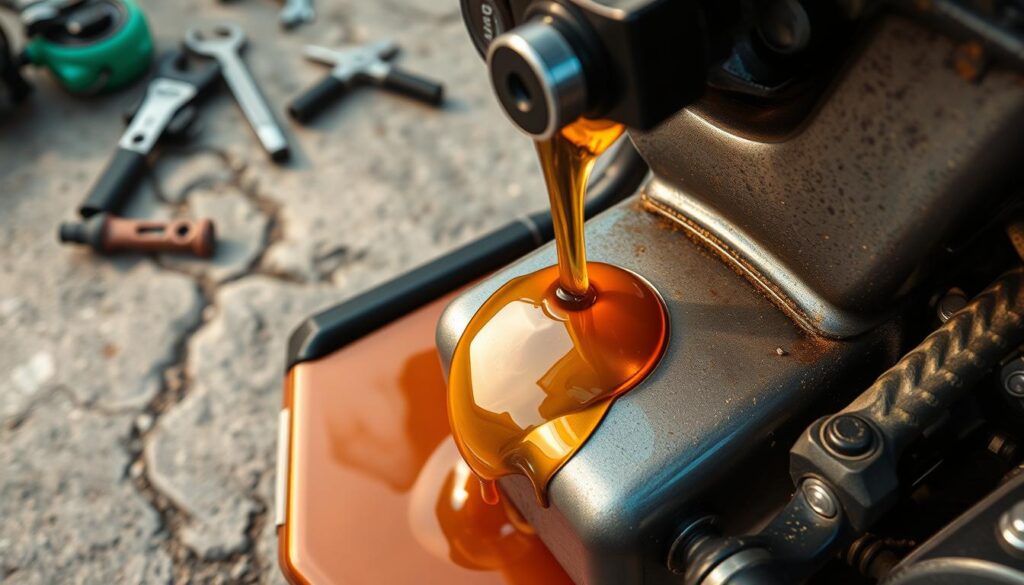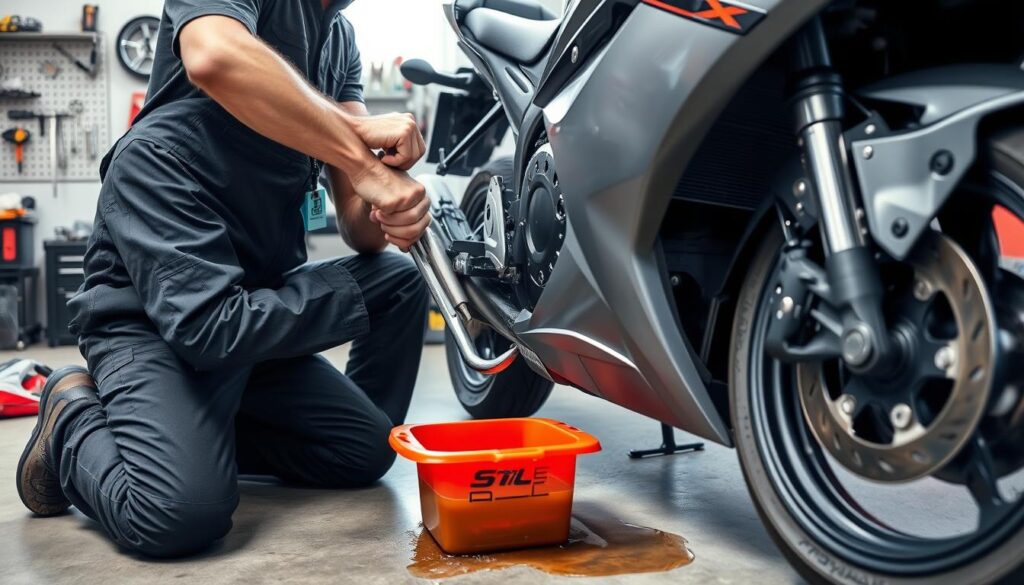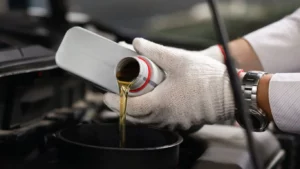I love motorcycles and know how important it is to keep them running well. One mistake many riders make is overfilling their bike’s oil. It might seem like a small error, but it can cause big problems. In this guide, I’ll explain the dangers of overfilling your motorcycle’s oil.

Key Takeaways
- Overfilling your motorcycle’s oil can lead to serious engine damage and performance issues.
- Identifying the signs of overfilled oil, such as oil leaks and foaming, is crucial to addressing the problem.
- Potential damages include wear and tear on engine components, increased oil consumption, and reduced fuel efficiency.
- Correctly checking and topping up your motorcycle’s oil level is essential to maintaining its longevity and optimal performance.
- Seeking professional help from a qualified mechanic is advisable if you’re unsure about the oil level or require assistance in draining excess oil.
Introduction to Motorcycle Oil and Its Importance
If you love motorcycles, you know how important keeping them in top shape is. The motorcycle engine oil is key to this. It helps your engine run smoothly.
Understanding the Role of Oil in Your Motorcycle’s Engine
The role of oil in a motorcycle engine is important. It reduces friction and prevents wear. It also helps keep the engine cool, avoiding damage.
Without enough oil, your engine will wear out fast. This hurts its performance and lifespan.
Why Maintaining Proper Oil Level is Crucial
Keeping the proper oil level in your motorcycle is vital. Too little oil can cause problems, and too much can lead to leaks and more. It’s important to keep the oil level right.
Knowing how motorcycle engine oil works helps you take care of your bike. This keeps it running well and saves you money in the long run.
“Proper oil maintenance is the foundation of a healthy motorcycle engine.”
What Happens If I Overfill My Motorcycle with Oil
Overfilling your motorcycle’s oil can harm your engine’s performance and lifespan. Too much oil creates high pressure and makes the oil foam. This reduces lubrication and increases wear on important parts. Also, the extra oil can leak into other engine parts, causing damage.
Overfilling affects your engine’s internal parts badly. The extra oil increases drag on the crankshaft, leading to more fuel use and less power. The foaming oil also makes it harder for the engine to lubricate itself, causing more friction and wear.
Another problem with overfilling is oil leaks. The extra oil can leak through seals and gaskets, dripping onto the engine and other parts. This can make a mess and attract dirt, making the problem worse.
In extreme cases, the oil can get into the combustion chamber, causing “wet fouling.” This makes the spark plugs misfire, leading to poor engine performance and more emissions. In the worst cases, the engine can seize, requiring expensive repairs.
To avoid these problems, follow the manufacturer’s oil capacity guidelines and check the level often. Keeping the oil at the right level helps your engine run smoothly and efficiently. This protects its parts and extends its life.
Signs of Overfilled Motorcycle Oil
It’s key to spot signs of overfilled motorcycle oil early. This helps avoid bigger problems. As a motorcycle fan, always check your bike’s oil level. This way, you catch overfill issues before they get worse.
Identifying the Telltale Symptoms
Here are some common symptoms of overfilled motorcycle oil:
- Oil leaks: Too much oil can leak from your motorcycle. This can cause spills that are both unsightly and dangerous.
- Excessive oil consumption: If your bike uses oil too fast, it might be overfilled.
- Difficulty starting the engine: Too much oil can make it hard for your engine to start.
- Unusual engine noises or vibrations: Excess oil can cause strange sounds or vibrations. This means there’s a problem.
By watching for these signs of overfilled motorcycle oil, you can fix the issue early. Regular checks and maintenance are key. They help keep your bike running well and lasting longer.
“Staying on top of your motorcycle’s oil level is crucial for maintaining its health and performance. Don’t ignore the warning signs – address any overfill issues right away to avoid costly repairs down the line.”
Potential Damages Caused by Overfilling
Overfilling your motorcycle’s oil can harm your engine’s parts and performance. Too much oil can cause many problems. These issues can shorten your bike’s life and make it less efficient.
Effects on Engine Components
Too much oil can damage seals and gaskets, causing leaks. This can also contaminate other important systems. The oil may foam and lose its ability to lubricate. This can wear down bearings, pistons, and other moving parts.
Risks to Motorcycle Performance
The problems caused by overfilled motorcycle oil can hurt your bike’s performance. It can make your engine less efficient, reduce power, and even fail. These risks are serious if you don’t fix the effects of overfilled oil on engine components.
| Potential Damage | Impact on Performance |
|---|---|
| Oil Leaks | Contamination of other systems, decreased engine efficiency |
| Reduced Lubrication | Increased wear on bearings, pistons, and other moving parts |
| Engine Failure | Catastrophic damage, leading to costly repairs or replacement |
It’s clear that damages from overfilling motorcycle oil can seriously affect your bike. Keeping the oil level right is key to your motorcycle’s health. This ensures it runs well and lasts longer.
How to Correctly Check and Top Up Motorcycle Oil
Keeping the right oil level in your motorcycle is key for its best performance and life span. To keep your bike in top shape, follow these steps to check and top up the oil correctly.
Checking the Oil Level
First, check your owner’s manual for the right oil type and amount for your motorcycle. This will help you know how to check the oil level. You’ll use the dipstick or a sight glass to see the oil level.
- Find the dipstick or sight glass, usually on the engine’s side.
- Take out the dipstick and clean it with a lint-free cloth.
- Put the dipstick back in and pull it out again. The oil level should be between the minimum and maximum marks.
Topping Up the Oil
If the oil level is low, it’s time to add more. Make sure to use the correct oil type and amount, as your manual says. Adding too much oil can harm your bike, so add it slowly.
- Find the oil fill cap, usually on the engine’s top.
- Open the cap and add oil slowly, checking the level after each pour.
- Stop adding oil when the level hits the maximum mark on the dipstick.
- Put the oil fill cap back and tighten it well.
By following these steps to how to check motorcycle oil level and how to top up motorcycle oil correctly, you’ll keep your motorcycle’s oil at the perfect level. This will prevent any problems or damage.
Draining Excess Oil from Your Motorcycle
If you’ve overfilled your motorcycle’s oil, it’s important to act fast. This guide will help you drain the extra oil. This ensures your engine runs smoothly.
Locating the Drain Plug
The first step is to find the drain plug. It’s usually at the bottom of the oil sump or pan. This is where the extra oil will come out.
Preparing the Workspace
Put a catch pan or container under the drain plug to catch the oil. Make sure the area is clean. This prevents debris from getting into the new oil.
Draining the Excess Oil
- Use the right tool to unscrew the drain plug. This lets the extra oil drain out.
- Watch the oil level as it drains. Make sure to remove the right amount to get to the recommended level.
- When the oil level is right, put the drain plug back on. Tighten it well.
Disposing of the Used Oil
Dispose of the used oil correctly, following local environmental rules. Many auto parts stores or mechanics offer recycling services. Check what’s best in your area.
If you’re having trouble or unsure, get help from a professional mechanic. Draining excess oil is key to keeping your motorcycle healthy and running well.

| Step | Action |
|---|---|
| 1 | Locate the drain plug, typically at the bottom of the oil sump or pan |
| 2 | Place a catch pan underneath to collect the used oil |
| 3 | Carefully unscrew the drain plug to allow the excess oil to drain out |
| 4 | Monitor the oil level and stop draining once the proper level is reached |
| 5 | Replace the drain plug and tighten it securely |
| 6 | Dispose of the used oil properly according to local regulations |
Preventing Overfilling in the Future
To avoid overfilling your motorcycle’s oil, follow some best practices. These tips will keep your engine running smoothly and prevent expensive repairs. It’s all about keeping your motorcycle in top shape.
Tips and Best Practices
- Always check your owner’s manual for the right oil type and amount. This is key to keeping the right oil level in your motorcycle.
- Use a funnel when adding oil to prevent spills and avoid overfilling.
- Regularly check the oil level before and after riding. This helps you spot any issues and fix them quickly.
- Never go past the maximum fill line on your dipstick or in the manual. Overfilling can cause serious engine problems.
- Be careful when changing the oil. Measure the new oil carefully to avoid overfilling.
- Dispose of any extra oil properly. This keeps your engine running at its best.
By following these best practices for maintaining proper motorcycle oil level, you can avoid the problems of overfilling your motorcycle’s oil in the future. A well-maintained engine means a long-lasting and reliable motorcycle.
“The best way to avoid the headache of overfilled motorcycle oil is to be proactive and diligent in your maintenance routine.”
When to Seek Professional Help
Dealing with too much oil in your motorcycle might seem easy. But, there are times when a pro mechanic’s help is crucial. If you’re not sure how bad the damage is or how to fix it, a certified tech can help. They can check your bike and fix it right.
A professional mechanic can help you in several ways:
- They can find out why you have too much oil. This could be a problem with the oil system or a faulty part. They’ll fix it so it doesn’t happen again.
- They have the tools and know-how to safely remove the extra oil. This way, they won’t hurt your motorcycle’s engine.
- If you’ve had too much oil for a while, they can see how it’s affected your engine. They’ll tell you what repairs you need.
- They can also give you tips on keeping the right oil level. This helps avoid future problems.
Getting professional help for overfilled motorcycle oil ensures the problem is fixed right. It keeps your motorcycle running well for a long time. Don’t wait to call a certified technician when to get a mechanic for motorcycle oil overfill. Their skills can save you from expensive fixes later.

Maintaining Optimal Oil Level: A Key to Motorcycle Longevity
Keeping your motorcycle’s oil level right is key for its long life. It ensures your engine runs smoothly and lasts longer. By checking and topping up the oil regularly, you’ll make your engine last longer and ride better.
Benefits of Proper Oil Maintenance
Proper oil level is crucial for your bike’s health. It reduces engine wear and tear, saving you money on repairs. It also keeps your engine cool, protecting it from damage.
Regular oil checks catch problems early. This saves you time and money. By focusing on oil maintenance, you’ll enjoy a better riding experience for years.
FAQ
What are the consequences of overfilling my motorcycle with oil?
Overfilling your motorcycle’s oil can harm your engine. Too much oil can make the engine work harder and wear out faster. It can also leak into other parts, causing damage.
How can I identify the signs of an overfilled motorcycle oil tank?
Look out for signs like oil leaks and hard engine starts. You might also hear unusual noises or feel vibrations.
What kind of damages can be caused by overfilling my motorcycle’s oil?
Too much oil can damage seals and gaskets, leading to leaks. It can also make the oil foam, reducing its ability to lubricate. This can wear down engine parts.
How do I correctly check and top up the oil in my motorcycle?
Check your owner’s manual for the right oil type and amount. Use the dipstick or sight glass to check the oil level. Add oil slowly, checking often to avoid overfilling.
How do I drain the excess oil from my motorcycle if I’ve overfilled it?
Start by finding the drain plug at the bottom of the oil sump. Place a pan underneath and unscrew the plug. Once the level is right, replace the plug and dispose of the used oil.
What are some best practices to prevent overfilling my motorcycle’s oil in the future?
Always check your owner’s manual for oil recommendations. Use a funnel to avoid spills. Check the oil level before and after riding. Never go over the maximum fill line.
When should I seek professional help for an overfilled motorcycle oil situation?
If you’re not sure how to fix it, get a mechanic’s help. They can check your bike and fix any damage. They can also help prevent future overfilling.






